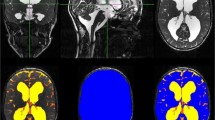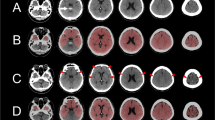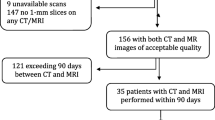Abstract
Purpose
The purpose of this study was to evaluate the association of asymmetric lateral ventricle (ALV) with clinical and structural pathologies and assess its clinical importance.
Materials and methods
We analyzed 170 consecutive ALV cases on computed tomography (CT) and 170 control group patients with normal head CT. Patients who had apparent etiologic causes for ALV were excluded. The differential diagnosis of ALV and unilateral hydrocephalus (UH) was made by using three different ventricle-brain ratios (VBRs). The measurements of the ALV were made at the frontal horn level. Patients with asymmetry were divided into three subgroups including mild, moderate and severe groups to eloborate the grade of the ventricular asymmetry. Additional CT findings including septal deviation, diffuse enlargement, atrophy and the densities of constant sites were also recorded systematically for each patient. Clinical and handedness data were collected and analyzed.
Results
The prevalence of ALV in the study population was 6.1%. Headache was the most common reason for head CT examination and was significantly more common in the asymmetry group (61.7% in group A, 42.9% in group B, P = 0.001). Transient ischemic attack, focal neurologic findings, vertigo, ataxia, visual and hearing disturbances were similar in both groups (P > 0.5). There was no difference in smoking and alcohol habits in both patient groups. Ten (5.8%) patients in group A and 16 (9.4%) patients in group B had neuropsychiatric disorders, which did not achieve statistical significance. In group A patients, the larger ventricle was more common in the left side than in the right (left = 70.0%, right = 30.0%). Group A consisted of 57.0% mild (grade 1, n = 97), 26.5% moderate (grade II, n = 45) and 16.5% severe (grade III, n = 28) patients. There was no significant correlation between handedness and ALV. The density of different brain sites was found close similar on both sides in ALV and control group (P > 0.5). Choroidal cystic or solid neoplasm or periventricular dysplasia was detected in six ALV patients in group A (3.5%), on their additional MR examinations.
Conclusion
The physician should not overlook an ALV finding on unenhanced CT, particularly in cases with severe degree of asymmetry or diffuse ventricular enlargement, and search for possible accompanying disorders.


Similar content being viewed by others
References
Achiron R, Yagel S, Rotstein Z, Inbar O, Mashiach S, Lipitz S (1997) Cerebral lateral ventricular asymmetry: is this a normal ultrasonographic finding in the fetal brain? Obstet Gynecol 89:233–237
Artmann H, Grau H, Adelmann M, Schleiffer R (1985) Reversible and non-reversible enlargement of cerebrospinal fluid spaces in anorexia nervosa. Neuroradiology 27:304–312
Bergsneider M, Holly LT, Lee JH, King WA, Frazee JG (1999) Endoscopic management of cysticercal cysts within the lateral and third ventricles. Neurosurg Focus 4:e7
Cha S, George AE (2002) How much asymmetry should be considered normal variation or within normal range in asymmetrical frontal horns of the lateral ventricles noted during CT brains scans without evidence of midline shift or any other significant lesion? AJR Am J Roentgenol 1:240
Deisenhammer E, Hammer B (1983) Unilateral ventricular reflux and asymmetric ventricular distribution of intrathecally introduced contrast medium or tracer. AJNR Am J Neuroradiol 3:564–565
Dolcos F, Rice HJ, Cabeza R (2002) Hemispheric asymmetry and ageing: Right hemisphere decline or asymmetry reduction. Radiology 26:819–825
Erdogan AR, Dane S, Aydin MD, Ozdikici M, Diyarbakirli S (2004) Sex and handedness differences in size of cerebral ventricles of normal subjects. Intern J Neurosci 114:67–73
Frye RE, Polling JS, Ma LC (2007) Choroid plexus papilloma expansion over 7 years in Aicardi syndrome. J Child Neurol 22:484–487
Fukuda H, Kobayashi S, Koide H, Yamaguchi S, Okada K, Shimode K, Tsunematsu T, Komatsu A (1990) Age-related changes in cerebral white matter measured by computed cranial tomography. Comput Med Imaging Graphics 14:79–84
Grossman H, Stein M, Perrin RC, Gray R, St Louis EL (1990) Computed tomography and lateral ventricular asymmetry: clinical and brain structural correlates. Can Assoc Radiol J 6:342–346
Harcherik DF, Cohen DJ, Ort S, Paul R, Shaywitz BA, Volkmar FR, Rothman SL, Leckman JF (1985) Computed tomographic brain scanning in four neuropsychiatric disorders of childhood. Am J Psychiatry 6:731–734
Hulshoff Pol HE, Schnack H, Mandl RC, Brans RG, van Haren NE, Baare WF, van Oel CJ, Collins DL, Evans AC, Kahn RS (2006) Gray and white matter density changes in monozygotic and same-sex dizygotic twins discordant for schizophrenia using voxel-based morphometry. Neuroimage 31:482–488
Largen JW, Simith RC, Calderon M, Baumgartner R, Lu RB, Schoolar JC, Ravichandran GK (1984) Abnormalities of brain structures and density in schizophrenia. Biol Psychiatry 7:991–1013
Lemay MJ (1984) Radiological changes of the ageing brain and skull. AJR Am J Roentgenol 143:383–389
Parizec J, Jakubec J, Hobza V, Nemeckova J, Cernoch Z, Sercl M, Zizka J, Spacek J, Nemecek S, Suba P (1998) Choroid plexus cyst of the left lateral ventricle with intermittent blockage of the foramen of monro, and initial invagination into the III. Ventricle in a child. Childs Nerv Syst 12:700–708
Radaideh MM, Leeds NE, Kumar AJ (2002) Unusual small choroids plexus cyst obstructing the foramen Monro: case report. AJNR Am J Neuroradiol 5:841–843
Shapiro R, Galloway SJ, Shapiro MD (1986) Minimal asymmetry of the brain: a normal variant. AJR Am J Roentgenol 147:753–756
Shirakawa N, Mukai K, Fujisawa H, Furuichi S (1991) A case of intraventricular cyst associated with normal pressure hydrocephalic condition. No Shinkei Geka 9:897–902
Tien R, Harrsh GR, Dillon W.P, Wilson CB (1990) Unilateral hydrocephalus caused by an intraventricular venous malformation obstructing the foramen of monro. Neurosurgery 4:664–666
Weinberger DR, Luchins DJ, Morhisa J, Wyatt RJ (1982) Asymmetrical volumes of the right and left frontal and occipital regions of the human brain. Ann Neurol 11:97–100
Winchester P, Brill PW, Cooper R, Krauss AN, Peterson HD (1986) Prevalence of ‘‘compressed’’ and asymmetric lateral ventricles in healthy full-term neonates: sonographic study. AJNR Am J Neuroradiol 7:149–153
Author information
Authors and Affiliations
Corresponding author
Rights and permissions
About this article
Cite this article
Kiroğlu, Y., Karabulut, N., Oncel, C. et al. Cerebral lateral ventricular asymmetry on CT: how much asymmetry is representing pathology?. Surg Radiol Anat 30, 249–255 (2008). https://doi.org/10.1007/s00276-008-0314-9
Received:
Accepted:
Published:
Issue Date:
DOI: https://doi.org/10.1007/s00276-008-0314-9




